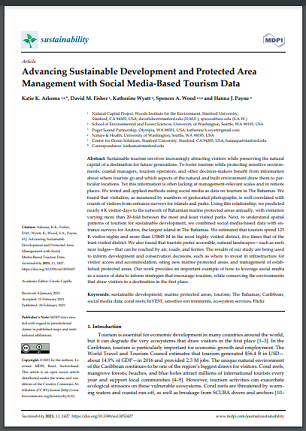
Sustainable tourism involves increasingly attracting visitors while preserving the natural capital of a destination for future generations. To foster tourism while protecting sensitive environ‐ ments, coastal managers, tourism operators, and other decision‐makers benefit from information about where tourists go and which aspects of the natural and built environment draw them to particular locations. Yet this information is often lacking at management‐relevant scales and in remote places. We tested and applied methods using social media as data on tourism in The Bahamas. We found that visitation, as measured by numbers of geolocated photographs, is well correlated with counts of visitors from entrance surveys for islands and parks. Using this relationship, we predicted nearly 4 K visitor‐days to the network of Bahamian marine protected areas annually, with visitation varying more than 20‐fold between the most and least visited parks. Next, to understand spatial patterns of tourism for sustainable development, we combined social media‐based data with en‐ trance surveys for Andros, the largest island in The Bahamas. We estimated that tourists spend 125 K visitor‐nights and more than US$45 M in the most highly visited district, five times that of the least visited district. We also found that tourists prefer accessible, natural landscapes—such as reefs near lodges—that can be reached by air, roads, and ferries. The results of our study are being used to inform development and conservation decisions, such as where to invest in infrastructure for visitor access and accommodation, siting new marine protected areas, and management of estab‐ lished protected areas. Our work provides an important example of how to leverage social media as a source of data to inform strategies that encourage tourism, while conserving the environments that draw visitors to a destination in the first place.






